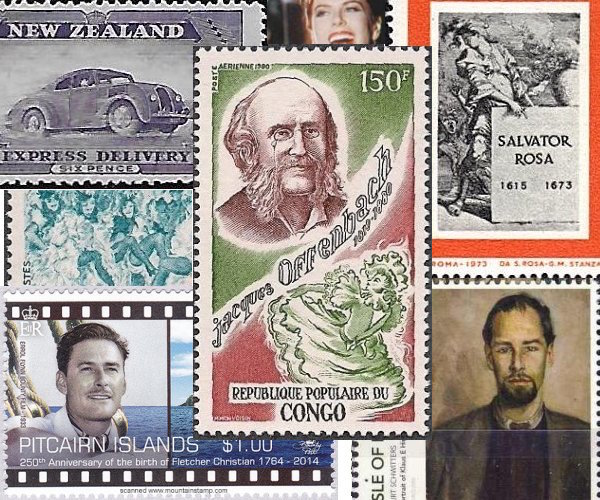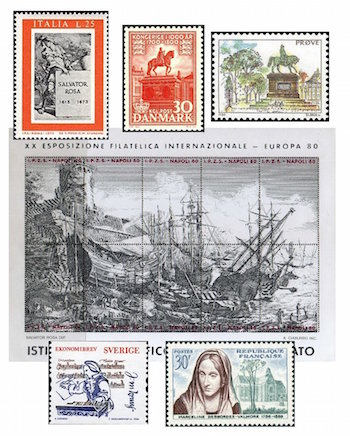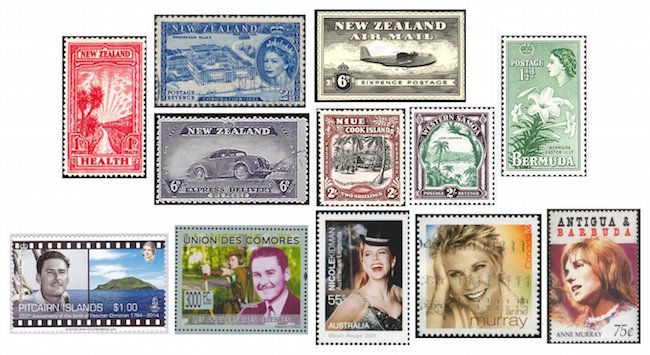The Arts on the Stamps of the World — June 20
An Arts Fuse regular feature: the arts on stamps of the world.

By Doug Briscoe
Of the pre-20th-century artistic figures born on June 20, the most familiar, I suppose, would be Jacques Offenbach, whose fame, however, among present-day audiences anyhow, is surely eclipsed by three popular performers (two of whom happen to have come from Australia): Errol Flynn, Nicole Kidman, and singer Anne Murray. We’ll come to them all in due time. First, it’s back to the seventeenth century we go.
As a painter, Salvator Rosa (June 20 or July 21, 1615 – March 15, 1673) has been aptly described as “proto-Romantic”. A glance at his Self-Portrait: Philosophy (1640) will show a brooding temperament that would not be out of place alongside Byron and Delacroix. Rosa was active in Naples, Rome, and Florence, and besides painting was a prolific producer of etchings, as well as expressing his gifts in poetry, plays, trenchant satires, and as a musician and actor. For a time a number of musical compositions were erroneously attributed to him, but other than providing texts for at least four cantatas by Pietro Cesti he does have at least three classical music connections. The best known, I suppose, is the piano piece by Liszt called “Canzonetta del Salvator Rosa”, which is Liszt’s treatment of the song “Vado ben spesso cangiando loco“. As it turns out, however, that song was actually composed by Giovanni Bononcini. There is also a ballet called Catarina (1846) by Cesare Pugni, based on an alleged episode from Rosa’s life, and an opera called Salvatore Rosa (1874) by the Brazilian composer Carlos Gomes. (E. T. A. Hoffmann, himself a composer, also wrote a novella about Salvator Rosa called Signor Formica in 1819.) In addition to the Italian Salvator Rosa stamp of 1973 (for the tricentenary of his death), I wanted to include a sheet reproducing his Port at Sunset. These are not postage stamps, but rather a memento for the International Philatelic Exhibition that took place in Rosa’s native Naples in 1980.

The peripatetic French-born sculptor Jacques Saly (20 June 1717 – 4 May 1776) offered his services to Denmark, Italy and Malta besides his homeland. The Danish connection is the one that made its way to a postage stamp. The equestrian statue of King Frederik V occupied Saly from 1753 to 1768. You’ll notice I said “stamp” (singular), but that two stamps are shown; the second one was a prospective design that was never put into print. But to begin at more or less the beginning, Saly was apprenticed at age nine to a local Valenciennes sculptor, moving on to the Royal Academy in Paris in 1732. He won three medals there, the last of which was the coveted Prix de Rome, enabling Saly to study in Rome, where he lived from 1740 to 1748. On his return to France he was commissioned to do a standing statue of Louis XV. (Sadly, it was destroyed during the Revolution.) In the same year, 1752, he made a plaster bust of Madame de Pompadour. After the long Danish excursion, Saly came back home one last time in 1775, dying the next year at age 59. Here’s a 1772 portrait of him by the Danish portraitist Jens Juel.
Another 18th-century artist who left home to serve at a Scandinavian court was German composer Joseph Martin Kraus (20 June 1756 – 15 December 1792). He was admired by Haydn, for whom Kraus wrote a symphony to be performed at Esterháza; he belonged to the same Masonic Lodge as Mozart, of whom he was an almost exact contemporary, having died at about the same age. Kraus went to Sweden at the age of 21 and died in Stockholm fifteen years later. Among his best known works are a funeral cantata and symphony for the assassinated King Gustav III (whose story served as the basis of Verdi’s Ballo in maschera). The stamp was issued, along with stamps for Mozart and Carl Michael Bellman, in 2006.
French poet and novelist Marceline Desbordes-Valmore (20 June 1786 – 23 July 1859) was born in Douai to a family that lost its wealth in the Revolution. Marceline accompanied her mother to Guadeloupe in search of assistance from relatives, her mother died there of yellow fever, and the sixteen-year-old girl made her way back to France, where she began a life on the stage as an actress and singer. She published her first poetry in 1819 and her first prose work two years later. The poetry volume, Élégies et Romances, is seen as a forerunner of the Romantic movement. Balzac said that Desbordes-Valmore was the inspiration for Cousin Bette.

I know of seven stamps honoring composer Jacques Offenbach (1819-1880), but I own a copy of only one of them (the French one—I swiped the other images here from the ‘Net). You might be surprised to learn that four of the other six were issued by African nations: Benin (two designs), the People’s Republic of Congo, and Gabon. I don’t bother to include the Monagasque stamp for Gaîté Parisienne, since we just saw it the day before yesterday, but here’s one for the ballet Le papillon of 1860, issued by New Zealand as a 50th anniversary celebration of that nation’s Royal Ballet.
Next up is German artist Kurt Schwitters (in full, Kurt Hermann Eduard Karl Julius Schwitters; 20 June 1887 – 8 January 1948). An epileptic, the Hanover-born Schwitters was not drafted until late in World War I, and like much other art of the age his later work reflected aspects of mechanization as a result. It was around this time that he coined the term Merz, derived from the phrase Commerz und Privatbank (commerce and private bank) and first used in his collage Das Merzbild (The Merz Picture, 1918-19). He even put out a periodical with the title Merz from 1923 to 1932; thereafter Schwitters pretty much discarded the use of the term. Schwitters was another polymath like Salvator Rosa and yesterday’s José Rizal, also producing work in the areas of poetry and sound as well as in painting, sculpture, collage, graphic design, and typography. He left Germany for Norway in order to avoid an invitation to have a little sit-down with the Gestapo, was briefly interned there after Germany invaded that country, then moved on to Scotland and the Isle of Man, where he was also interned as an enemy alien. (This is why there’s a stamp from the Isle of Man along with the German one. The stamp from the Maldive Islands celebrates not Schwitters himself but rather the 700th anniversary of his birthplace, Hanover.) Released in 1941, he lived in London and the Lake District for his remaining days.
Italian painter and printmaker Giorgio Morandi (July 20, 1890 – June 18, 1964) came from Bologna, where he studied at the Art Academy. He dabbled in Futurism and the Metaphysical Art movement of Giorgio de Chirico (birthday next month) and Carlo Carrà. His output was largely devoted to still lifes (two of them seen on these Italian stamps) with the occasional landscape and a few self-portraits. (Here’s one.) Morandi’s pictures figure prominently in two landmark Italian films, Fellini’s La Dolce Vita and Antonioni’s La notte.

Once more we turn to an artist responsible for a great many stamp designs, in his case more than a thousand. James Berry (20 June 1906 – 6 November 1979) was born in London but lived in New Zealand from 1925. His first stamp design was a 1933 allegorical semi-postal depicting “the road to health”. Other samples here are his lovely coronation stamp for Queen Elizabeth and—a first here on The Arts on the Stamps of the World—a special delivery stamp. They don’t make those any more; the last U.S. one came out in 1971. Another Berry design, one that regrettably never made it to press, is the handsome gray 6p airmail stamp. Besides his many pieces for New Zealand, Berry also provided designs for Western Samoa, the Cook Islands, Niue, Tonga, and Bermuda. I’ve selected a few of those for your viewing pleasure. Very recently we’ve had occasion to use Berry’s designs for other purposes as seen in these pages: the one for John Smeaton’s lighthouse and the one for George Frampton’s Peter Pan statue, seen here just two days ago. Berry also created the images for some of New Zealand’s first decimal coins in 1967.
Today’s Big Stars have graciously offered to come last. Two of them are Berry’s national neighbors. Errol Flynn, born in Tasmania on this date in 1909, will probably get a U.S. stamp sooner or later (he became a citizen in 1942). The attractive stamp from the Pitcairn Islands (another first for today’s AoSotW) celebrates the bicentennial of the birth of Fletcher Christian. (I guess they couldn’t get the rights to Clark Gable’s image. Or Marlon Brando’s. Or Mel Gibson’s.) For the record, Flynn played Christian in what was his first lead role, in an Australian docudrama called In the Wake of the Bounty (1933). Errol Flynn died of heart and liver failure on 14 October 1959, aged 50. His countrywoman Nicole Kidman, coincidentally, turns 50 today. (Can you believe it?) She shows up on an Australian stamp of 2001, featuring a still taken from that year’s Baz Luhrman monstrosity Moulin Rouge!
Finally, we salute Canadian adult contemporary singer Anne Murray (born June 20, 1945). The first Canadian woman to hit No. 1 on American charts, she has sold over 55 million albums and can be found on two stamps, one from her native Canada and the other from Antigua.
Another American artist who I expect will one day appear on a U.S. stamp is jazz alto saxophonist and wind player Eric Dolphy, Jr. (June 20, 1928 – June 29, 1964). And happy birthday to four worthies who are happily still with us: English film director Stephen Frears (born 1941), American pianist André Watts (1946), American actor John Goodman (1952), and Indian novelist and poet Vikram Seth (1952).
A graduate of the University of Massachusetts with a B.A. in English, Doug Briscoe worked in Boston classical music radio, at WCRB, WGBH, and WBUR, for about 25 years, beginning in 1977. He has the curious distinction of having succeeded Robert J. Lurtsema twice, first as host of WGBH’s weekday morning classical music program in 1993, then as host of the weekend program when Robert J.’s health failed in 2000. Doug also wrote liner notes for several of the late Gunther Schuller’s GM Recordings releases as well as program notes for the Boston Classical Orchestra. For the past few years he’s been posting a Facebook “blog” of classical music on stamps of the world, which has now been expanded to encompass all the arts for The Arts Fuse.

In a Knopf 1976 book about Nadar, there is a deathbed photo of Desbordes-Valmore, and another from a life sitting. I had been unaware of her before David Evitts showed me his copy of the book on Nadar.